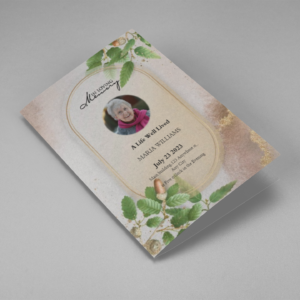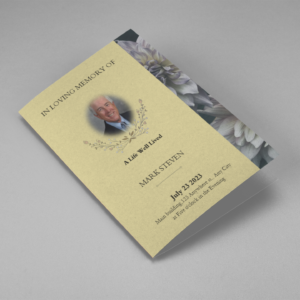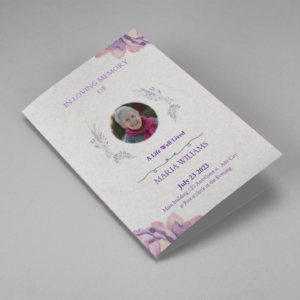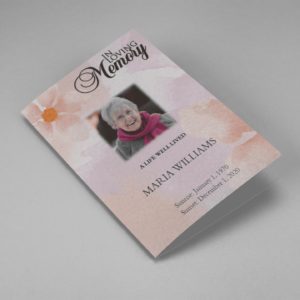Creating an obituary is a meaningful way to honor a loved one’s life and legacy. A well-designed traditional obituary template provides a structured, respectful format to share memories, celebrate achievements, and announce details about funeral services. This guide explores the elements of Traditional Obituary Layouts and offers tips for creating an elegant and impactful design.
Understanding Traditional Obituary Layouts
1. The Structure of a Traditional Obituary
A traditional obituary typically follows a structured layout, ensuring important details are clearly conveyed. Common elements include:
- Headline/Title: Often reads “In Loving Memory of [Name]” or simply the deceased’s name and dates of birth and death.
- Introduction: A brief opening statement announcing the passing of the individual.
- Biographical Information: Includes the person’s full name, age, place of birth, and a short summary of their life achievements, education, and career.
- Family Details: Lists surviving family members and those who have preceded the deceased in death.
- Funeral or Memorial Service Details: Includes the date, time, and location of services.
- Special Tributes: Short poems, religious texts, or meaningful quotes.
- Closing Statement: Expresses gratitude to those offering condolences or invites readers to a reception following the service.
2. Choosing the Right Layout for a Traditional Obituary
Selecting a layout that aligns with the tone and purpose of the obituary is essential. Traditional templates are often designed with the following considerations:
- Elegance: Subtle colors, formal fonts, and classic borders.
- Readability: Well-organized sections with clear headings.
- Simplicity: Minimalistic designs that emphasize the content over graphics.
Key Elements in a Traditional Obituary Template
1. Fonts and Typography
The choice of fonts is crucial for maintaining a traditional look. Serif fonts like Times New Roman or Georgia are popular for their classic and formal appearance.
2. Borders and Decorations
Simple, elegant borders frame the obituary, giving it a polished look. Floral motifs, scrolls, or religious symbols are commonly used.
3. Colors
Traditional layouts typically use subdued colors such as black, white, gray, or soft pastels to reflect the somber yet respectful tone.
4. Imagery
Including a photograph of the deceased, preferably a portrait that represents them at their happiest, is a key element in many templates.
5. Paper Type
Traditional obituaries are often printed on high-quality paper, such as linen or card stock, to enhance the presentation.
Creating a Traditional Obituary Template
Step 1: Gather Necessary Information
Start by collecting all relevant details, including biographical information, family names, and service details.
Step 2: Select a Template
Choose a professionally designed traditional obituary template to ensure an organized and refined look. Many templates are available online, including free and customizable options.
Step 3: Customize the Content
Tailor the template by inserting the deceased’s details, ensuring accuracy and sensitivity.
Step 4: Proofread and Finalize
Review the content carefully for any errors. Have another family member or friend check for accuracy before printing.
Examples of Traditional Obituary Templates
1. Simple One-Page Layout
This layout includes all essential elements in a single page, making it concise and easy to read. It often features a central photo and a border.
2. Two-Column Format
The two-column design divides the content into readable sections, with the biography on one side and family and service details on the other.
3. Folded Card Style
This style mimics a small booklet, offering additional space for personal tributes, poems, or messages of thanks.
Why Use a Traditional Obituary Template?
1. Consistency and Clarity
A structured template ensures that all critical information is included and presented clearly.
2. Time-Saving
Templates simplify the process during a challenging time, allowing families to focus on personalization rather than formatting.
3. Professional Appearance
Traditional designs lend an air of dignity and professionalism, ensuring the obituary reflects the respect the deceased deserves.
Obituary Templates
-
Searching for a Oak Leaf With Gold Oval Frame Half Page Funeral Program that is easy to print and amass and has a cutting-edge look? The Oak Leaf With Gold Oval Frame Half Page Funeral Program is the Perfect decision because it measures 8.5”x 5.5”.
- No Limitation on Content, Edit anything
- Edit anytime – unlimited revisions even after purchased
- Get a printable PDF downloaded to get it printed on your own.
-
Searching for a Brown and White Classic Funeral Program Half Page Program that is easy to print and amass and has a cutting-edge look? The Brown and White Classic Funeral Program Half Page Program is the Perfect decision because it measures 8.5”x 5.5”.
- No Limitation on Content, Edit anything
- Edit anytime – unlimited revisions even after purchased
- Get a printable PDF downloaded to get it printed on your own.
-
Searching for a Purple Elegant Watercolor Half Page Funeral Program Template that is easy to print and amass and has a cutting-edge look? The Purple Elegant Watercolor Half Page Funeral Program Template is the Perfect decision because it measures 8.5”x 5.5”.
- No Limitation on Content, Edit anything
- Edit anytime – unlimited revisions even after purchased
- Get a printable PDF downloaded to get it printed on your own.
-
Searching for a Cream and Green Photo Obituary Half Page Program that is easy to print and amass and has a cutting-edge look? The Cream and Green Photo Obituary Half Page Program is the Perfect decision because it measures 8.5”x 5.5”.
- No Limitation on Content, Edit anything
- Edit anytime – unlimited revisions even after purchased
- Get a printable PDF downloaded to get it printed on your own.
-
Searching for a Cream Simple Elegant Photo Church Half Page Program that is easy to print and amass and has a cutting-edge look? The Cream Simple Elegant Photo Church Half Page Program is the Perfect decision because it measures 8.5”x 5.5”.
- No Limitation on Content, Edit anything
- Edit anytime – unlimited revisions even after purchased
- Get a printable PDF downloaded to get it printed on your own.
-
Searching for a Samovar Silver Half Page Funeral Program Template that is easy to print and amass and has a cutting-edge look? The Samovar Silver Half Page Funeral Program Template is the Perfect decision because it measures 8.5”x 5.5”.
- No Limitation on Content, Edit anything
- Edit anytime – unlimited revisions even after purchased
- Get a printable PDF downloaded to get it printed on your own.
-
Searching for an Elegant Beige Half Page Funeral Program Template that is easy to print and amass and has a cutting-edge look? The Elegant Beige Half-Page Funeral Program Template is the Perfect decision because it measures 8.5”x 5.5”.
- No Limitation on Content, Edit anything
- Edit anytime – unlimited revisions even after purchased
- Get a printable PDF downloaded to get it printed on your own.
-
Searching for a White Floral Pro Half Page Funeral Program Template that is easy to print and amass and has a cutting-edge look? White Floral Pro Half Page Funeral Program Template is the Perfect decision because it measures 8.5”x 5.5”.
- No Limitation on Content, Edit anything
- Edit anytime – unlimited revisions even after purchased
- Get a printable PDF downloaded to get it printed on your own.
-
Searching for a Grey and Burgundy Elegant Half Page Funeral Program Template that is easy to print and amass and has a cutting-edge look? Grey and Burgundy Elegant Half Page Funeral Program Template is the Perfect decision because it measures 8.5”x 5.5”.
- No Limitation on Content, Edit anything
- Edit anytime – unlimited revisions even after purchased
- Get a printable PDF downloaded to get it printed on your own.
-
Searching for a Soft Green and Grey Minimalist Floral Half Page Funeral Program Template that is easy to print and amass and has a cutting-edge look? Soft Green and Grey Minimalist Floral Half Page Funeral Program Template is the Perfect decision because it measures 8.5”x 5.5”.
- No Limitation on Content, Edit anything
- Edit anytime – unlimited revisions even after purchased
- Get a printable PDF downloaded to get it printed on your own.
-
Searching for a Gray Elegant Oval Frame Half Page Funeral Program Template that is easy to print and amass and has a cutting-edge look? Gray Elegant Oval Frame Half Page Funeral Program Template is the Perfect decision because it measures 8.5”x 5.5”.
- No Limitation on Content, Edit anything
- Edit anytime – unlimited revisions even after purchased
- Get a printable PDF downloaded to get it printed on your own.
-
Searching for a Blue Organic Minimal Half Page Funeral Program Template that is easy to print and amass and has a cutting-edge look? Blue Organic Minimal Half Page Funeral Program Template is the Perfect decision because it measures 8.5”x 5.5”.
- No Limitation on Content, Edit anything
- Edit anytime – unlimited revisions even after purchased
- Get a printable PDF downloaded to get it printed on your own.
-
Searching for a Pink and Orange Watercolour Half Page Funeral Program Template that is easy to print and amass and has a cutting-edge look? Pink and Orange Watercolour Half Page Funeral Program Template is the Perfect decision because it measures 8.5”x 5.5”.
- No Limitation on Content, Edit anything
- Edit anytime – unlimited revisions even after purchased
- Get a printable PDF downloaded to get it printed on your own.
-
Searching for a Pink Floral Paper Half Page Funeral Program Template that is easy to print and amass and has a cutting-edge look? Pink Floral Paper Half Page Funeral Program Template is the Perfect decision because it measures 8.5”x 5.5”.
- No Limitation on Content, Edit anything
- Edit anytime – unlimited revisions even after purchased
- Get a printable PDF downloaded to get it printed on your own.
Templates Of Obituary : Helping Videos
Most Frequently Asked Question On Traditional Obituary Template Layouts
Can I customize a traditional obituary template?
Yes, most traditional templates are fully customizable, allowing you to adjust fonts, colors, and layout to suit your preferences.
What is the best type of paper for printing obituaries?
High-quality paper like linen or card stock is ideal for traditional obituaries. These options provide a formal and durable finish.
Should I include a photo in the obituary?
Including a photo is a personal choice, but it adds a warm, personal touch to the obituary and helps celebrate the deceased’s life.
How long should a traditional obituary be?
The length can vary, but traditional obituaries typically range from 300 to 800 words, depending on the details included.















